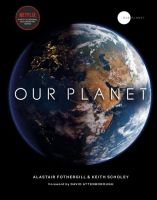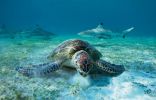 Tytuł: Nasza planeta
Tytuł: Nasza planeta
Tytuł oryginału: Our Planet
Autor(zy): Alastair Fothergill, Keith Scholey
Tłumaczenie: Magdalena Hermanowska
Rok wydania: 2019 (ENG), 2019 (PL)
Wydawnictwo: Bantam Press (ENG), Rebis (PL)
Dlaczego w bazie: Książkowe uzupełnienie pierwszego sezonu serii Our Planet, z paroma żółwimi wzmiankami i jednym żółwim zdjęciem. Wszystkie żółwie elementy poniżej:
Around its shores, the waters teem with life. In this 'bathtub ring of biodiversity’ lurk crocodiles, water cobras, terrapins and more unique species tha in the Galapagos Islands.
SEAGRASS GRAZER
A green turtle grazes on seagrass in a bay off Misool, one of the Indonesian Raja Ampat islands. Behind, blacktip reef sharks patrol in search of small fish and other sea creatures. This bay – once a shark-finning camp – is now part of a rich marine reserve, transformed in less than a decade. The seagrass provides food, habitat and nursery areas for numerous fish and other species, stabilizes the seabed and filters out pollution. Seagrass plants need light and therefore clear water to grow, and they can easily be smothered by sediment run-off or algal blooms caused by agricultural or other land pollution.
The dense meadows are also home to turtles, dugongs and their close relations, manatees.
The reserve encompasses 120,000 hectares (296,525 acres) of reefs that had previously been damaged by dynamite fishing, general overfishing and shark fishing. But such activities are now banned, and at the heart of the reserve is a 'no-take zone’ where all fishing and other activities such as collecting turtle eggs are prohibited.
The villagers have leased part of the reef to a high-end diving resort, which generates tourist revenues. In return they also receive incomes from jobs as park rangers and pilots on patrol boats that see off foreign fishing boats after shark fins and turtles.
Better news is that, in 2017, oil prospecting was banned from around the 300-kilometre-long (190-mile) Belize Barrier Reef, home to some 1.400 marine species, including hawksbill turtles, manatees, rays and six types of shark, and part of the Mesoamerican Reef, the largest reef system in the western hemisphere.


Autor: XYuriTT
